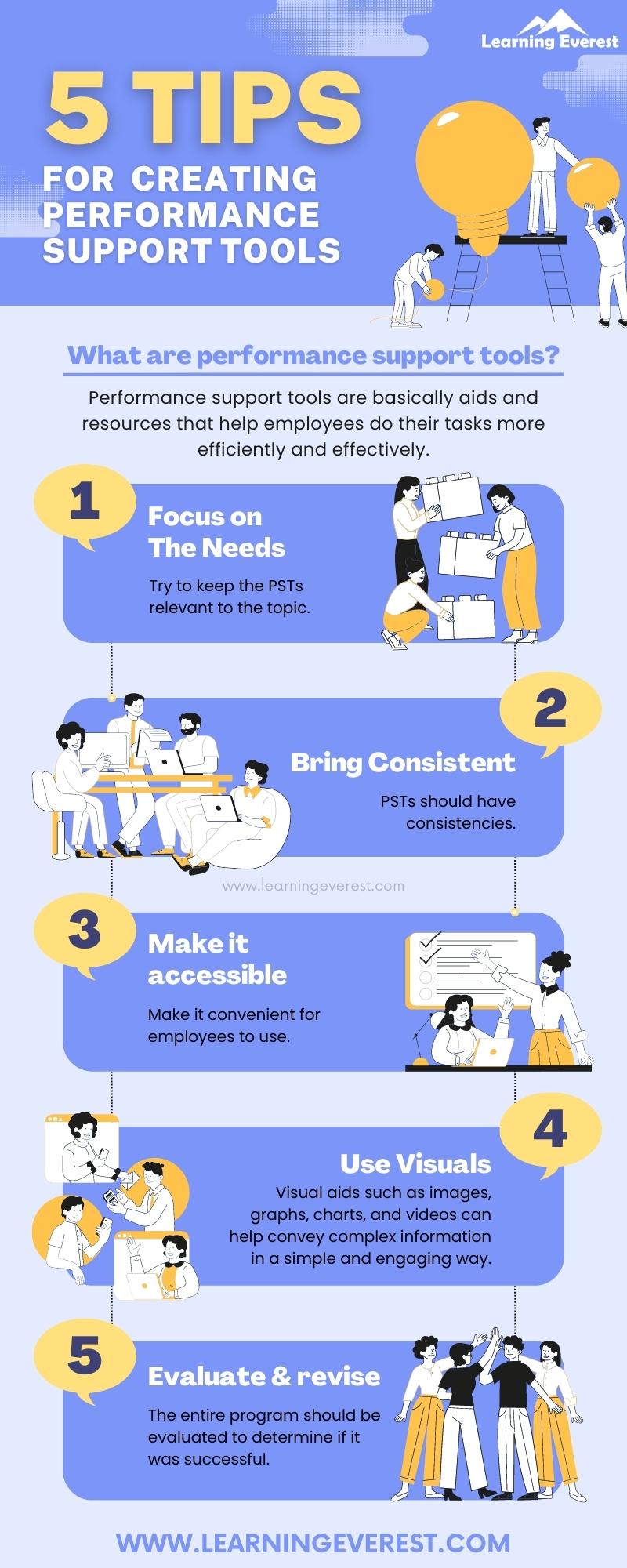Performance support tools (PSTs) are job aids and resources that help employees do their tasks more efficiently and effectively. These tools can come in a written or digital format. Performance support tools can be used by organizations who wants to train their employees quickly. But it is not without its challenges. Below we discuss the common challenges in implementing performance support tools as well as how to overcome them.
Table of Contents
- The challenges in implementing performance support tools
- Challenge 1: Organizations are not ready to adopt new-age training approaches
- Challenge 2: There is still a lack of awareness and understanding
- Challenge 3: Challenges in performance support tools also include technological barriers
- Challenge 4: It is not easy to create relevant content for performance support
- Challenge 5: It is difficult to integrate performance support tools with existing processes
- Challenge 6: It is not easy to measure success and ROI
- Infographic
- To wrap up
- Frequently Asked Questions (FAQs)
- What are performance support tools?
- What are four 4 performance support tools?
- What are the benefits of performance support tools?
The challenges in implementing performance support tools
Here are 6 common challenges in implementing performance support tools and how to overcome them:
Challenge 1: Organizations are not ready to adopt new-age training approaches
Introducing new tools can be difficult to adopt for employees who are comfortable with existing methods. Some employees may be reluctant to adopt performance support tools due to a fear of change or a lack of familiarity with technology.
Solution: Overcoming resistance requires effective communication, training, and demonstrating the benefits of the performance support tools.
Challenge 2: There is still a lack of awareness and understanding
Employers are not aware of the existence or benefits of performance support tools yet. They perhaps do not understand how these tools can enhance the performance of the employees or make their tasks easier.
Solution: It is crucial to educate employers and communicate with employees about the purpose, features, and advantages of the performance support tools to ensure their successful adoption.
Challenge 3: Challenges in performance support tools also include technological barriers
Implementing performance support tools often involves integrating technology systems, software, or mobile applications. Organizations may face challenges related to compatibility, technical infrastructure, or data security.
Solution: It is essential to conduct a thorough assessment of the existing technology landscape, address any technical gaps, and ensure that the performance support tools align with the organization’s IT infrastructure and security requirements. Implementing performance support tools may require training employees on how to use the tools effectively. Providing adequate training and support materials is important. It helps employees understand how to access and utilize the performance support tools easily. It is important to offer ongoing support during the implementation phase and beyond.
Challenge 4: It is not easy to create relevant content for performance support
Creating and maintaining relevant and up-to-date content for performance support tools can be a significant challenge. Content development requires subject matter experts, instructional designers, and technical writers to collaborate and produce accurate and effective materials. Additionally, maintaining content requires regular updates to reflect changes in processes, systems, or industry practices.
Solution: Organizations need to allocate resources and establish processes for content development and maintenance to ensure the effectiveness and relevance of the performance support tools.
Challenge 5: It is difficult to integrate performance support tools with existing processes
Performance support tools should seamlessly integrate with existing workflows and processes to be truly effective.
Solution: Aligning the tools with the specific needs and tasks of employees can be challenging, especially in complex or highly specialized work environments. Organizations should conduct thorough analysis and design phases to identify the training gaps and align the performance support tools with existing processes, ensuring smooth integration and minimal disruption.
Challenge 6: It is not easy to measure success and ROI
Evaluating the effectiveness of performance support tools and measuring the return on investment (ROI) is challenging.
Solution: Determining the impact of these tools on employee performance, productivity, and overall business outcomes requires clear performance metrics and data analysis. Organizations should establish key performance indicators (KPIs) and implement mechanisms to track and measure the success of the performance support tools.
Infographic

Challenges in implementing performance support tools Infographic
To wrap up
By acknowledging and proactively addressing these challenges, organizations can successfully implement performance support tools and maximize their potential to enhance employee performance, improve productivity, and drive organizational success.
Contact us at Learning Everest to see how we can help you today!
Frequently Asked Questions (FAQs)
What are performance support tools?
Performance support tools are resources that help employees perform their tasks efficiently and effectively. These tools can be in the form of software applications, job aids, checklists, infographics, or instructional videos.
What are four 4 performance support tools?
Four performance support tools are job aids, social learning platforms, video tutorials, and mobile apps.
What are the benefits of performance support tools?
By using performance support tools, employees can reinforce their knowledge, apply it in real-time, and retain information through practical application.





